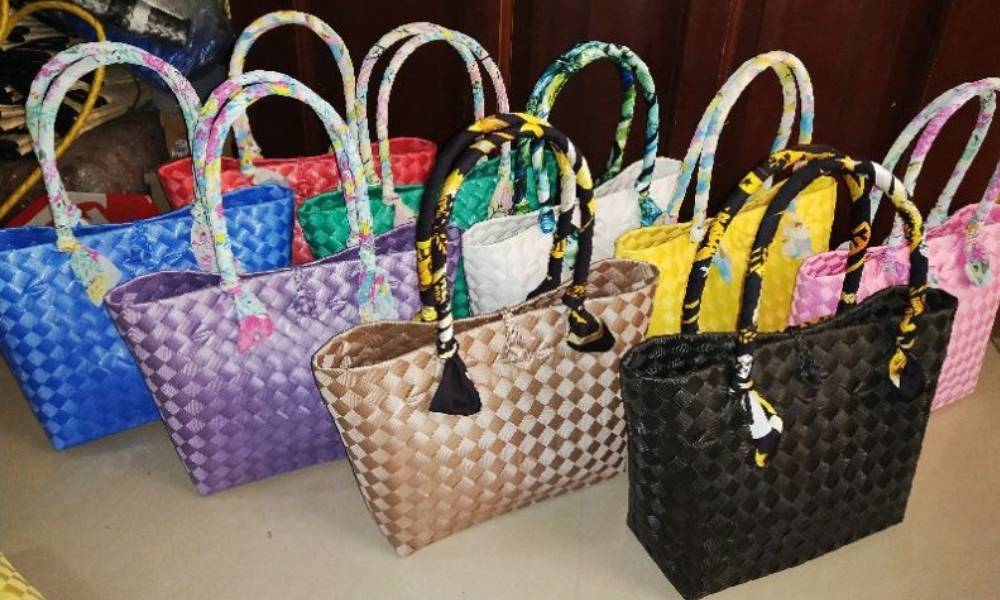Bayong: Philippine Woven Bags

Origin of Bayong
Bayong is a traditional hand-woven bag in the Philippines made of buri palm leaves (also known as Genus Corypha, gebang palm, or talipot palm) in Visayas and of pandan (also known as Genus Pandanus, screw palm, or screw pine) in Luzon.
This handicraft has been such a long and major part of the country’s culture that its specific history and date of origin aren’t identified, only widely described as “passed down through many generations.”
What Are Filipino Woven Bags Made Of?
While they are both made with native leaves, buri and pandan faintly look and feel different — well — to unfamiliar individuals at least. Corypha or buri comes from the massive leaves of buri palm that are flattened and dried into wide, soft strips. Local bags made with this material usually turn out clean, structured, and smooth. You can barely feel the texture due to sleekness, but it retains its head-turning, unique rustic look.
Pandanus, on the other hand, is tougher, more fibrous, and louder with its texture. It takes serious skill to work with. But that raw, rugged look? It shows! Pandanus bayongs have that little edgy look.
Some modern bayongs in foreign areas are made from plastic strips. If you search online, you’ll see many DIY videos about people creating their own bayong tote using this material. This kind pretty much defeats its purpose of reducing plastic waste and showing off the beauty of the Philippines’ culture, but it’s understandable. They find it beautiful, and it’s not like you can just buy buri or pandan at the convenience store.
Uses of the Philippine Bayong
Utility Bag
Bayong was originally used as an everyday reusable shopping bag for items bought from the wet market or palengke. With an under-over weaving technique, they are relatively sturdy if woven tightly and securely. They are also waterproof thanks to the buri and palm leaves; perfect for putting in fish, meat, or anything that’s wet or moist. Because of this, it is also commonly used by farmers and fishermen for their produce and catch.
Even though Philippine woven bags have now taken many different shapes and sizes, the classic square bayong is what is commonly used for this purpose. If you want to switch to this eco-friendly bag and ditch the plastic, try this one from Telebrico’s Handicraft!
Daily Bag for Work or Errands
The thing about this cultural Filipino bag is that it is not only functional, but also chic enough to be used as a daily bag for work or errands, depending on the style. Some put a lock on it by zipper or string.
Have you heard of the brand Bottega Veneta? It’s a woven fashion specializing in bags. Many people believe that its design is unspokenly inspired by the Philippine bayong. Along with this brand, there are many other bags in the market that have seemingly gotten inspiration from this native bag.
This goes to show how great Filipino craftsmanship can influence other cultures. The bayong is even a popular Philippine souvenir taken home by tourists. That’s just how iconic it is!
Check out this hamper bayong and hamper bayong with zipper!
Laundry Basket or Hamper
The bayong’s rustic, homey look also makes it a perfect laundry basket for your home. This is actually quite common because it provides all that you may look for in a hamper: sturdy, easy to move, spacious, and a little bit stylish.
Telebrico’s Handicraft also offers customized laundry baskets made with your preferred colors. What makes them even better is that it has a zipper cover to prevent overflowing laundry and keep a neat look in your home, blending them well with the aesthetic!
How to Make a Bayong
Here are 5 Steps in Making a Bayong
Get your materials
Harvest and dry your buri or pandan leaves, or recycled plastic. Once dried, cut the material into strips of even width. If you want it in your favorite color, dye first before cutting.
Form the base
To start the base of the bayong, cross the strips to form a tight, flat square or rectangular base using an under-over weaving technique. The strength of the bayong depends heavily on this foundation.
Weave the sides
After forming the base, fold the edges upward and continue weaving the strips vertically to build the sides. The pattern must be consistent to maintain shape and durability. Make sure to adjust the tightness as needed to keep the bag sturdy.
Finish the top
Once you’ve reached the desired height, fold or weave in the ends to finish the top. This locks the structure in place.
Add the handles
For the last step, attach braided or wrapped handles. They are typically made from the same or complementary material and are woven through the upper part of the bayong or sewn securely.






